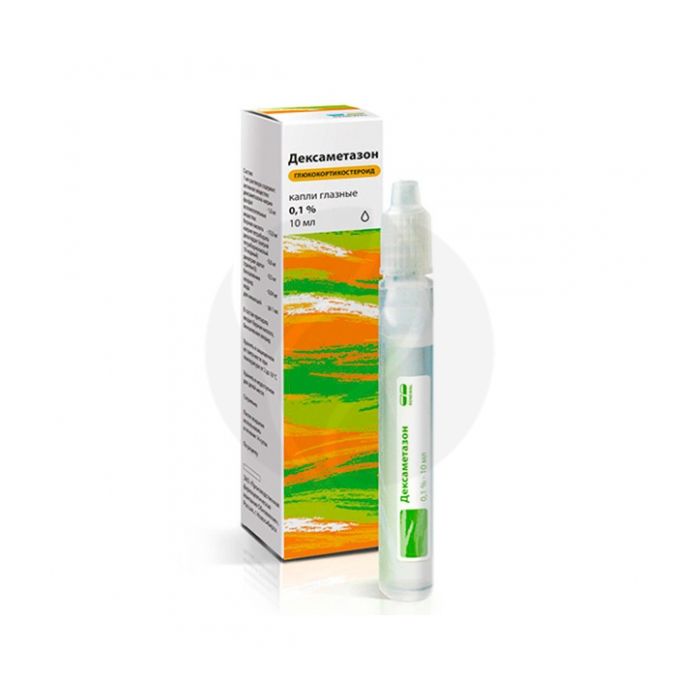Dexamethasone eye drops 0.1%, 10ml
Expiration Date: 05/2027
Russian Pharmacy name:
Дексаметазон капли глазные 0,1%, 10мл
Non-purulent and allergic conjunctivitis,
keratitis,
keratoconjunctivitis without damage to the epithelium,
iritis,
iridocyclitis,
blepharoconjunctivitis,
blepharitis
episcleritis,
sclerites,
inflammatory process after eye injuries and surgical interventions,
sympathetic ophthalmia.
For adults with a pronounced inflammatory process, during the first 24-48 hours of treatment, 1-2 drops are instilled into the conjunctival sac every 2 hours, with a decrease in inflammation - every 4-6 hours.
For the prevention of inflammatory processes after eye operations and injuries during the first 24 hours after the operation, the drug is instilled 4 times / day, then for 2 weeks - 3 times / day.
Eye drops in the form of a colorless, transparent liquid.
1 ml
dexamethasone sodium phosphate 1 mg
Excipients: boric acid - 15 mg, sodium tetraborate decahydrate (sodium tetraborate 10-aqueous) - 0.6 mg, disodium edetate (Trilon B) - 0.5 mg, benzalkonium chloride - 0.04 mg, water d / i - up to 1 ml.
Bacterial, viral, fungal eye diseases,
tuberculous lesion of the eyes,
violation of the integrity of the ocular epithelium,
an acute form of purulent eye infection in the absence of specific therapy,
corneal diseases associated with epithelial defects,
trachoma,
glaucoma.
pharmachologic effect
Fluorinated GCS, has a pronounced anti-inflammatory, anti-allergic and anti-exudative effect. By interacting with a specific protein receptor in target tissues, it regulates the expression of corticoid-dependent genes and thus affects protein synthesis. Reduces the formation, release and activity of inflammatory mediators (histamine, bradykinin, prostaglandins, lysosomal enzymes). Suppresses cell migration to the site of inflammation; reduces vasodilation and increased vascular permeability in the focus of inflammation. Stabilizes lysosomal enzymes of leukocyte membranes; suppresses the synthesis of antibodies and disrupts antigen recognition. Inhibits the release of interleukin-1 and interleukin-2, interferon gamma from lymphocytes and macrophages. Induces the formation of lipocortin,inhibits the release of inflammatory mediators by eosinophils and stabilizes mast cell membranes. All of these effects are involved in suppressing the inflammatory response in tissues in response to mechanical, chemical, or immune damage. The duration of the anti-inflammatory action after the instillation of 1 drop of the solution is from 4 to 8 hours.
Pharmacokinetics
After instillation into the conjunctival sac, it penetrates well into the corneal epithelium and conjunctiva; while in the aqueous humor of the eye, therapeutic concentrations are achieved; with inflammation or damage to the mucous membrane, the rate of penetration increases. About 60-70% of dexamethasone entering the systemic circulation binds to plasma proteins. It is metabolized in the liver by cytochrome-containing enzymes; metabolites are excreted through the intestines. T1 / 2 averages 3 hours.
Side effect
With prolonged use (more than 3 weeks), an increase in intraocular pressure is possible; the development of glaucoma with damage to the optic nerve, decreased visual acuity and loss of visual fields, as well as the formation of posterior subcapsular cataract, thinning and perforation of the cornea is also possible; very rarely - the spread of herpes and bacterial infections. Allergic conjunctivitis and blepharitis may develop in patients with hypersensitivity to dexamethasone or benzalkonium chloride. Skin irritation, itching and burning are possible; dermatitis.
Application during pregnancy and lactation
No studies have been conducted on the safety and efficacy of dexamethasone in pregnant and lactating women. The drug can be used only if the significance of the effect for the mother outweighs the risk of developing side effects of the fetus and child.
Application in children
Contraindicated in children and adolescents under the age of 18.
special instructions
During treatment (for more than 2 weeks), it is necessary to monitor the intraocular pressure and the state of the cornea. When instilling in, soft contact lenses must be removed; they can be put on again no earlier than after 15-20 minutes. Within 30 minutes after installation, you must refrain from activities that require increased attention.
Treatment with the drug can mask the picture of a bacterial or fungal infection, therefore, when treating infectious eye diseases, the drug should be combined with adequate antimicrobial therapy.
Overdose
Symptoms: the dose-dependent side effects described may increase.
Treatment: there is no specific antidote. The drug should be canceled and symptomatic therapy should be carried out.
Drug interactions
With prolonged use with idoxuridine, it is possible to enhance destructive processes in the corneal epithelium.

